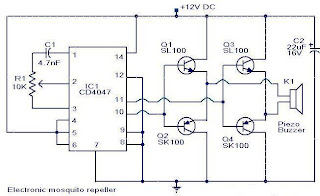- A simple AM receiver circuit based on the MK484 AM receiver IC from Rapid Electronics Ltd is shown here. MK4844 is a monolithic integrated circuit that has all the necessary sections of a AM receiver like RF amplifier, detector, AGC etc. The IC is available in TO92 package and requires very few external components.
- In the circuit L1 and C1 forms a tank circuit. L1 also serves as the antenna coil. The audio signals available at the pin 3 of IC1 are amplified using the amplifier built around transistor Q1.
- C2 is a bypass capacitor while C3 is a DC decoupler. Capacitor C4 provides negative feedback while R4 biases the transistor Q1.
NOTES:
- Assemble the circuit on a vero board.
- Use a 1.5V cell for powering the circuit.
- Never give more than 2V to the circuit. It will destroy the IC.
- The MK484 can be operated over a range of 150 KHz to 3 MHz.
- For L1 make 90 turns of 36SWG enamelled copper wire on a 1cm diameter card board former. Experiment with thenumber of turns for getting optimum performance. A little trial and error is needed.
























